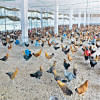How many eggs are there in our basket?

An egg market is a textbook example of perfect competition. There are many sellers and many buyers. All sellers and buyers see the eggs as identical. The only difference is that the eggs are either white or brown. No egg farm and no final consumer can influence the price on a particular day. Econ 101 then suggests that egg prices will be determined by the forces of supply and demand where nobody has market power.
In a highly competitive market like the egg market, one would expect prices to remain stable. They can rise, but over time.
The recent volatility in egg prices in Bangladesh suggests that the egg industry is experiencing shocks from one or multiple places. Keeping jargon and data aside, we can ask two simple questions. What causes egg prices to increase? What happens after this increase? This will help understand an industry that's been taken for granted for too long.
Feed is the main cost component
The main cost component in egg production is feed. This can be up to two-thirds of the total cost of producing eggs. Of this, corn and soybeans are the main ingredients.
Bangladesh has sufficient feed mill capacity. The poultry industry on its own consumes almost three-fourths of the feed mill production in the country. However, many small feed mills shut down when corn and soybean prices increased, which in turn raised the price of feed. Many small farmers stopped buying chicks because they were selling at a loss. They could not sustain loss over time due to small farm size.
Further challenges appeared in opening letters of credit (LC) due to volatility in the dollar exchange rate. This leads to temporary supply shortages where the available domestic feed becomes expensive.
The Covid pandemic and the Russia-Ukraine war led to a global supply disruption of vital feed ingredients in the countries from whom Bangladesh imports. Some countries that export these ingredients to Bangladesh are facing challenges to meet their own domestic demands. All this adds to an increasing feed cost. In the last few years, the margin between the selling price of broiler feed and its cost of production has made it a challenge for the feed industry to sustain.
High egg price means less revenue
Eggs are the main source of protein in low-income households in Bangladesh. Estimates suggest that the demand for eggs responds to price. If price increases by five percent, the demand will fall by more than five percent. Families will either consume fewer eggs or they will search for an alternative source. This is where the story gets messy.
In Bangladesh, the nearest alternatives to eggs as a source of protein in low-income households are fish such as tilapia and pangas, and in poultry it is broiler chicken. All three of these food items have become pricier over the last couple of years. Why? These markets are interlinked because of feed ingredients that are common to all.
Less egg sales have resulted in less revenue for farms. This has adversely affected small farms that have been surviving on razor-thin profits. Since 2020, egg farms in Bangladesh have had to absorb two shocks: first caused by Covid, and the second by an increase in the cost of feed, medicine and other inputs. Many egg farms had to close because they could not bear the losses.
How eggs travel from the farm to the final user
Egg farms in the country start from a few large corporate farms at the top to medium and small farms down the chain. Corporate farms usually auction their eggs and transport them to the wholesalers, or sell them through sales centres in large urban cities.
Small egg farms sell to a trader who collects eggs from several farms in an area. The trader takes the eggs to an urban market, like Tejgaon in Dhaka, where he sells them to a second trader. The second trader sells the eggs to retailers. So, between the small farmer and the consumer, there are at least two traders. This year, two factors contributed to rising egg prices. During summer this year, excessive heat led to hens finding it difficult to eat. This contributed to a fall in egg production. During monsoon this year, many small farms failed to transport their eggs to wholesalers. Supply fell. Prices of cheap fish, tilapia and pangas went up. Low-income households tried to switch to eggs as an alternative. The demand for eggs increased when the supply was already less than usual. Eggs sold at a high price during this shock.
There is one issue. The eggs that reach the final consumers in Bangladesh are all local eggs. When supply shocks appear, the government can't import eggs because there's a ban on egg imports. This is to protect and encourage the domestic industry. This has led to a status quo where an open market policy could backfire.
How much do we really know?
The beauty of competitive markets is that no seller or buyer can influence the industry. However, as we have seen, supply shocks can happen in the egg industry. Some of these shocks are structural and some are seasonal.
The beast of competitive markets is, during these supply shocks, the supply chain gets disrupted for a short period. Within this period, the scope for a quarter to reap benefits arises. However, in the absence of a comprehensive survey of the egg industry, it can be misleading to point at any quarter.
The time has arrived for state departments and ministries to conduct a comprehensive survey of the country's egg industry. The rationale is simple. Eggs are the cheapest source of protein for low-income households who don't have easily available alternatives to access. We need to know how many eggs we have in our basket.
Dr Asrar Chowdhury is professor of economics at Jahangirnagar University and a contributor to The Daily Star. He can be reached at [email protected].
Views expressed in this article are the author's own.
Follow The Daily Star Opinion on Facebook for the latest opinions, commentaries and analyses by experts and professionals. To contribute your article or letter to The Daily Star Opinion, see our guidelines for submission.

 For all latest news, follow The Daily Star's Google News channel.
For all latest news, follow The Daily Star's Google News channel. 








Comments